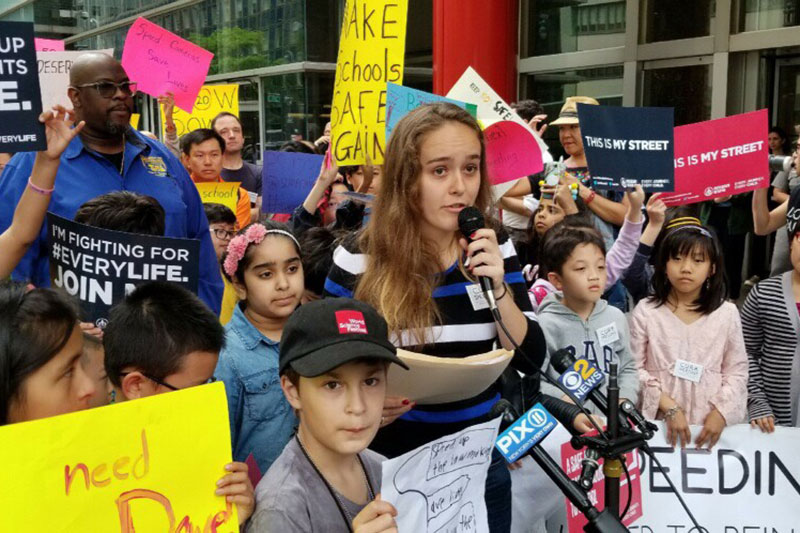Youth Leadership in Vision Zero

Alison de Beaufort, founder of the Vision Zero Youth Council, speaks at a rally for speed cameras in New York City (Image: FIA Foundation)
Whether on foot or a bike, in a parent’s car, or behind the wheel for the first time, transportation is a major part of life for youth as their independence grows. Students who walk or bike to school must contend with traffic in their neighborhoods and the school zone. And when they first start driving, students must learn how to prioritize safety both for themselves in the vehicle and for other road users.
Crashes impact youth, and often result from decisions where youth have had no opportunity for input. As a comprehensive approach to addressing safety, Vision Zero must account for all road users, those in and out of vehicles of all ages and abilities. Because of young people’s place in the transportation system, and the everyday needs of youth traveling to and from school and other commitments, youth engagement is a necessary and valuable component of any safety initiative like Vision Zero.
To be effective, youth engagement, moves beyond programs that simply inform youth of safety issues or attempt to educate to promote safety. Proper youth engagement allows youth to work as leaders in efforts to improve safety, whether that be advocating for changes to the built environment, spreading information among their peers about safe behavior, or developing other programs that address specific safety needs. By empowering youth to take the lead in these efforts, the better understand their role in the community and learn valuable skills for the future.
Youth engagement for safety – doing it right
Getting youth thoroughly engaged helps ensure programs are effective in developing understanding and helping promote traffic safety culture. Programs that have seen success enable youth to take on meaningful leadership roles that make them responsible for the group and the outcomes of their work. A local example of youth-led safety engagement from New York City is the Vision Zero Youth Council, a group started by a high school student in 2015. The group works to promote traffic safety culture among youth in the city while also advocating for citywide change to address needs that affect all road users. At a national level, Family, Career and Community Leaders of America (FCCLA) starts with classroom-based learning of safety concepts, including safe behavior and infrastructure that improves safety, and then empowers youth to promote changes in their community. Student members of FCCLA have worked on projects to promote safe driving for teens, educate younger students on bike safety, and push for crosswalk improvements near a school.
Representatives of each organization spoke on a webinar hosted by Vision Zero for Youth in September 2019. They shared a history of their organizations and some of their accomplishments. In addition, the youth leaders shared the following tips for adults to best support youth groups that are addressing traffic safety:
- Allow youth to take the lead and speak with each other rather than through an adult.
- Take an activity youth are already familiar with but add a street safety theme.
- Use moments with fewer planned activities or low attendance to brainstorm ideas for how the organization can grow and improve.
- Know your audience and tailor activities to age groups.
- Be present but keep it student led. Kids can inspire each other through their passions.
- Be there to provide advice and help, but don’t overshadow the students’ ideas. Provide guidance with explanation, but allow students to learn and work through problems
- Be ready to connect youth with other resources and organizations
For youth involved in groups addressing road safety, proper engagement provides a chance to have a voice in their community. The work rewards youth by helping them learn how to make a difference while seeing real improvements in safety for themselves and others outside their peer group. For the community and community leaders, youth emerge as true stakeholders. Rather than a system where elected officials and city staff make decisions that affect young people, communities that engage youth can begin to see these youth as ongoing partners in decision making.
